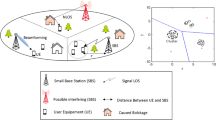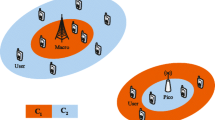Abstract
To meet the coverage requirement in the 5G cellular network, small cells are conceived as an emerging technology to increase coverage and satisfy the traffic demand. However, modeling and analysis coverage is the most important step in cell planning to explore the performance of system. Furthermore, with a large deployment of small cells in a Heterogeneous Network (Hetnet), the cross-tier interference management is a complex problem that needs to be studied. The main contribution of this paper is to analyze the downlink coverage performance for 5G Hetnet where the infrastructure is composed of Macro cell and Small cell. We model the received Signal to Interference plus Noise Ratio SINR at the user and we derive coverage probability according to Stochastic Geometry under different cognitive interference with and without coordination. Simulation result are provided to validate the proposed model.




Similar content being viewed by others
References
Agiwal, M., Roy, A., & Saxena, N. (2016). Next generation 5G wireless networks: A comprehensive survey. IEEE Communications Surveys & TutorialsIEEE, 18(3), 1617–1655.
Zhang, H., Jiang, C., Mao, X., & Chen, H. H. (2016). Interference-limited resource optimization in cognitive femtocells with fairness and imperfect spectrum sensing. IEEE Transactions on Vehicular Technology, 65(3), 1761–1771.
Kpojime, H. O., & Safdar, G. A. (2015). Interference mitigation in cognitive-radio-based femtocells. IEEE Communications Surveys & Tutorials, 17(3), 1511–1534.
Cheng, M., Wang, J. B., Wu, Y., Xia, X. G., Wong, K. K., & Lin, M. (2018). Coverage analysis for millimeter wave cellular networks with imperfect beam alignment. IEEE Transactions on Vehicular Technology, 67(9), 8302–8314.
Bai, T., Desai, V. R., & Heath, R. W. (2013). Analysis of blockage effects on urban cellular networks. IEEE Transactions on Wireless Communications, 13(9), 5070–5083.
Yan, Z., Zhou, W., Chen, S., & Liu, H. (2017). Modeling and analysis of two-tier hetnets with cognitive small cells. IEEE Access, 5, 16.
Elsawy, H., & Hossain, E. (2014). Two-tier hetnets with cognitive femtocells, downlink performance modeling and analysis in a multichannel environment. IEEE Transaction on Mobile Comput, 13(3), 649–663.
Akdeniz, M. R., Liu, Y., Samimi, M. K., Sun, S., Rangan, S., Rappaport, T. S., & Erkip, E. (2014). Millimeter wave channel modeling and cellular capacity evaluation. IEEE Journal on Selected Areas in Communications, 32(6), 1164–1179.
Rappaport, T. S., Gutierrez, F., Ben-Dor, E., Murdock, J. N., Qiao, Y., & Tamir, J. I. (2013). Broadband millimeter-wave propagation measurements and models using adaptive-beam antennas for outdoor urban cellular communications. IEEE Transactions on Antennas and Propagation, 61(4), 1850–1859.
Jafari, A. H., Pérez, D. L., Ding, M., & Zhang, J. (2017). Performance analysis of dense small cell networks with practical antenna heights under rician fading. IEEE Access, 6, 9960–9974.
Ouamri, M. A., Oteşteanu, M. E., Isar, A., & Aznia, M. (2020). Coverage, handoff and cost optimization for 5G heterogeneous network. Physical communication, 39, 1–8.
Andrews, J. G., Bai, T., Kulkarni, M. N., et al. (2017). Modeling and analyzing millimeter wave cellular systems. IEEE Transactions on Communication, 65(1), 403–430.
Yan, Z., Zhou, W., Chen, S., & Liu, H. (2016). Modeling and analysis of two-tier hetnets with cognitive small cells. IEEE Access, 5, 2904–2912.
Author information
Authors and Affiliations
Corresponding author
Additional information
Publisher's Note
Springer Nature remains neutral with regard to jurisdictional claims in published maps and institutional affiliations.
Appendix A
Appendix A
The PDF of distance \(d\) between the target UE and the closet Small Base Station can obtained in both LOS and NLOS cases by deriving the Cumulative Density Function CDF.
where \({\mathbb{P}}_{LOS} \left( d \right) = e^{ - \beta d}\) \({\mathbb{P}}_{NLOS} \left( d \right) = 1 - e^{ - \beta d}\) are the probability of a propagation path being LOS and NLOS respectively.
Rights and permissions
About this article
Cite this article
Ouamri, M.A., Azni, M. & Oteşteanu, ME. Coverage Analysis in Two-tier 5G Hetnet Based on Stochastic Geometry with Interference Coordination Strategy. Wireless Pers Commun 121, 3213–3222 (2021). https://doi.org/10.1007/s11277-021-08870-w
Accepted:
Published:
Issue Date:
DOI: https://doi.org/10.1007/s11277-021-08870-w




